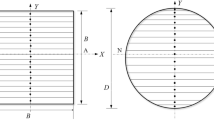Abstract
The paper presents an optimum leaflet valve design, for a given valve size, satisfying the design criteria of: (1) minimal stress concentration in the leaflets; (2) optimal cusp shape to effect a smooth washout upon valve closure and to provide minimal meridional surface contact between leaflets, so as to minimise haemolysis and prevent adjacent leaflets from sticking to each other; (3) the pressure difference across the leaflet, at valve opening, not exceeding a limiting value (specified, in this paper to be 1–4 mm Hg); and (4) to guarantee an adequate working life (of, say, 1–2×105 hours).
The valve leaflet is characterised as a shell surface with two principal radii of curvature R1, R2 and subtending angles θ1, θ2. These constitute the shape parameters of the valve design. The first two criteria, outlined above provide the following values of the shape parameters: θ1=150°, θ2=93°, R1=θ·89R, R2=θ·87R. The advocated leaflet material is Avcothan-51, selected on the basis of its biological compatibility. For this material, whose static and fatigue properties are available, the leaflet thickness is determined (for given valve size) in order to satisfy the third and fourth criteria (listed in the above paragraph) ensuring a valve opening leaflet pressure differential of 1–4 mm Hg and a prescribed lifetime T1 (of, say, 1–2×105 hours, the equivalent of 12–24 years).
Sommaire
L'article présente une conception optimale d'une valve à feuille pour valve de taille donnée et répondant aux critères de conception suivants: (1) concentration de contrainte minimum dans les feuilles; (2) forme optimum du sommet de façon à produire l'écoulement total régulier à la fermeture de la valve et à donner une surface de contact méridional minimum entre les feuilles afin de réduire le plus possible l'hémolyse et le collement des feuilles adjacentes les unes aux autres; (3) différence de pression à travers la feuille, à l'ouverture de la valve, ne dépassant pas une valeur limite (spécifiée dans cet article comme étant de 1 à 4 mm de mercure); et (4) durée de fonctionnement suffisante garantie (soit 1 à 2×105 heurs).
La feuille de valve est caractérisée par une face extérieure ayant deux rayons d'arc principauxR 1,R 2 sous tendus par des angles θ1,θ2. Ces données constituent les paramètres de forme pour la construction de la valve. Les deux premiers critères décrits ci-dessus donnent les valeurs suivantes aux paramètres de forme:θ 1=150°,θ 2=98°R 1=0,89R,R 2=0,87R. Le matériau de fabrication de la feuille, Avcothane-51, a été choisi pour sa compatibilité biologique. Pour ce matériau dont les propriétés statiques et de fatigue sont fournies, l'épaisseur de la feuille est déterminée (pour une valve de taille donnée) de façon à satisfaire les troisième et quartrième critères (énumérés au paragraphe ci-dessus) c'est à dire d'assurer une différence de pression de feuille d'ouverture de valve de 1 à 4 mm de mercure et une durée de fonctionnementT 1 prescrite (de par exemple 12×105 heures, soit l'équivalent de 12 à 24 ans).
Zusammenfassung
Diese Arbeit stellt eine optimale blättrige Klappenkonstruktion für eine gegebene Klappengröße vor, die folgende Konstruktionskriterien erfüllt: (1) minimale Beanspruchungskonzentration in den Blättern; (2) optimale Zipfelform zur Erzielung einer reibungslosen Ausspülung bei Klappenverschluß und eines minimalen meridionalen Flächenkontakts zwischen den Blättern, um die Hämolyse auf ein Mindestmaß zu beschränken und nebeneinanderliegende Blätter davor zu schützen, daß sie aneinanderkleben; (3) Gewährleistung, daß der Druckunterschied über das Blatt an der Klappenöffnung einen bestimmten Grenzwert nicht übersteigt (in dieser Arbeit mit 1–4 mm Hg festgelegt); und (4) Gewährleistung einer angemessenen Betriebslebensdauer (z.B. 1–2×105 Stunden).
Das Klappenblatt wird als Schalenfläche mit zwei Haupt-RundungsradienR 1,R 2 und zwei gegenüberliegenden Winkeln θ1, θ2 dargestellt. Dies sind die Formparameter der Klappenkonstruktion. Die ersten beiden Kriterien, die vorstehend umrissen werden, ergeben folgende Werte für die Formparameter:θ 1=150°,θ 2=98°,R 1=0,89R,R 2=0,87R. Das Material des Blattes, Avcothane, wurde aufgrund seiner biologischen Verträglichkeit gewählt. Für diesen Stoff, dessen statische und Ermüdungseigenschaften bekannt sind, wird die Stärke des Blattes bestimmt (für eine bestimmte Klappengröße), um das dritte und vierte Kriterium zu erfüllen (die im vorstehenden Absatz aufgeführt wurden). Dies gewährleistet einen Blattdruckunterschied beim Öffnen der Klappe von 1–4 mm Hg und eine vorgeschriebene BetriebslebensdauerT 1 (z.B. 12×105 Stunden, was 12–24 Jahren entspricht).
Similar content being viewed by others
References
Bellhouse, B. J. andTalbot, L. (1969) The fluid mechanics of the aortic valve.J. Fluid Mech. 35, 721.
Chong, P. K., Hwang, N. H. C. andWieting, D. S. (1971) Stress analysis of normal human aortic valve leaflets. Proceedings of 24th Annual Conference on Engineering in Medicine & Biology.
Flugge, W. (1962)Handbook of engineering mechanics. McGraw-Hill.
Gould, R. L., Cataloglu, A., Dhatt, G., Chattopadhyay, A. andClark, R. P. (1972) Stress analysis of the human aortic valve. National Symposium on Computerised Structural Analysis and Design, George Washington University, USA.
Hamid, M. S. andGhista, D. N. (1974) Finite element analysis of human cardiac structuresin Pulmano, V. A. andKabila, A. P. (eds.)Finite element methods in engineering. Clarendon Press, Oxford.
Muller, W. H., Warren, W. D., Dammann, J. F., Beckwith, J. andWood, J. E. (1960) Surgical relief of aortic insufficiency by direct operation on the aortic valve.Circ. 21, 587.
Pringle, D. A. andHarker, R. J. (1968) Environmental fatigue testing of moulded plastics for prosthetic heart valves. SESA Fall Meeting, San Francisco, Calif.
Yamada, H. (1973)Strength of biological materials. Williams & Wilkins, Baltimore.
Author information
Authors and Affiliations
Rights and permissions
About this article
Cite this article
Ghista, D.N. Toward an optimum prosthetic trileaflet aortic-valve design. Med. & biol. Engng. 14, 122–129 (1976). https://doi.org/10.1007/BF02478737
Received:
Accepted:
Issue Date:
DOI: https://doi.org/10.1007/BF02478737




